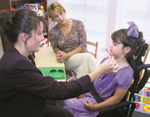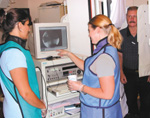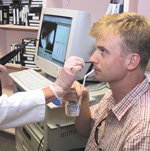Return to Main Menu
MUSC voice, swallowing center opens new location
The reception over and the opening of their new location celebrated, Bonnie Martin-Harris, Ph.D., and team returned Monday to celebrate the Evelyn Trammell Institute for Voice and Swallowing's mission "to provide the highest quality, seamless patient care.""We’re a highly specialized service," said Martin-Harris, the institute’s founder and director. “But we’re under one umbrella with the hospital and our intent is to bring together, not duplicate, services.”
She looks at the whole gamut of speech and swallowing from diagnosis and triage to possible surgery to therapy and voice or swallowing restoration. She clearly sees the institute’s narrow but necessary niche is one not as adequately filled by any other center in the country.
"We look at the functional interaction of muscles, nerves and tissues of the throat and neck and how they make the sounds that let us speak and sing or how they swallow our food and drink," Martin-Harris said. It’s because many of the same muscles, nerves and tissues are involved in both speaking and swallowing that the clinic studies and treats both functions.
Martin-Harris came to MUSC a year ago from St. Joseph’s Hospital in Atlanta where she established the Evelyn Trammell Voice and Swallowing Center and joined Lucinda Halstead who had established a voice program at MUSC in the late ‘80s, and the faculty of Otolaryngology.
The MUSC Evelyn Trammell Institute for Voice and Swallowing continues to collaborate with the Evelyn Trammell Voice and Swallowing Center at St. Joseph’s Hospital of Atlanta in clinical, educational, and research endeavors.
Martin-Harris is an internationally known speech pathologist, scientist and teacher who specializes in voice and swallowing and chairs the Inaugural Board on Specialty Board Recognition in Swallowing and Swallowing Disorders and serves in the Dysphasia Research Society. She is past coordinator of the ASHA (American Speech-Language-Hearing Association) Special Interest Division 13: Swallowing and Swallowing Disorders.
 Diane
Andrews, speech and language pathologist, holds a bubble blower for patient
Sarah Long, as mom Rebecca looks on. Andrews uses “play therapy” to treat
children with speech, language, swallowing, and feeding problems.
Diane
Andrews, speech and language pathologist, holds a bubble blower for patient
Sarah Long, as mom Rebecca looks on. Andrews uses “play therapy” to treat
children with speech, language, swallowing, and feeding problems.
The multidisciplinary team of the institute, which is comprised of speech pathologists, surgeons, voice teachers, and medical experts in the treatment of ear, nose and throat problems, works together to develop the most appropriate care plan for each patient.
Close collaboration is maintained with pulmonologists, gastoenter-ologists, head and neck surgeons, pediatric and adult neurologists, radiologists, audiologists and the MUSC Cochlear Implant Center.
The institute has some of the most advanced technologies available today, such as video stroboscopy, a sophisticated video technique that enables specialists to view and analyze the movement of vocal folds in simulated slow motion and high speed digital imaging of swallow function.
The institute, which is supported by funding from the Mark and Evelyn Trammell Foundation, provides professional training of clinically competent clinicians through academic preparation, mentoring of medical students, residents and junior faculty, and continuing education. It provides high quality, seamless patient care, and it conducts clinical research and dissemination of findings at national and international levels.
 Clinicians
at the Evelyn Trammell Institute examine a patient’s esophagus in a swallowing
study. The patient, right, swallowed water from a cup and the clinicians
took pictures of his throat via fiberoptic endoscopic and endoscopic video
techniques.
Clinicians
at the Evelyn Trammell Institute examine a patient’s esophagus in a swallowing
study. The patient, right, swallowed water from a cup and the clinicians
took pictures of his throat via fiberoptic endoscopic and endoscopic video
techniques.
Swallowing
Approximately 6 million people in the United States have some form
of swallowing disorder. Dyphasia, difficulty with swallowing, can occur
as a result of illness, injury or disease. Swallowing problems can significantly
affect the ability to receive safe and proper nutrition and hydration,
resulting in muscle weakness, fatigue, irritability, difficulty fighting
disease, breathing problems or pneumonia.
Symptoms
Warning signs of swallowing problems:
- Frequent throat clearing or coughing while eating or drinking
- Wet or gurgly sounding voice during or after eating or drinking
- Increased congestion in the chest after eating or drinking
- Food or liquid coming from the nose while eating or drinking
- Slow eating, which can lead to weight loss
- Multiple swallows on a single mouthful
- Feeling of food sticking in the mouth, throat or upper chest
- Fatigue or shortness of breath while eating or drinking
A team of professionals works together to develop a plan of care. The goal of the team is to return the patient to safe, effective swallowing, good nutrition and health.
 K.
Christian Walters participates in a swallowing study.
K.
Christian Walters participates in a swallowing study.
Voice
Vocal problems may occur when vocal folds suffer misuse or overuse.
Problems may also be associated with illness, stress, trauma or surgery.
Specialists at the Evelyn Trammell Institute for Voice and Swallowing are
especially sensitive to the frustrations and anxieties related to voice
problems, especially for those whose careers depend on their voice.
Evaluation
Following a physician’s referral, voice specialists fully evaluate
vocal abilities using state-of-the-art analysis, and provide recommendations
and treatment. The evaluation process is highly educational and interactive,
allowing patients to view video images of their own vocal folds. This process,
along with recommendations from the
specialist and physician, assists patients in making decisions for
care based on their needs.
Treatment
Voice specialists teach proper maintenance and hygiene of the voice.
When appropriate, they work closely with community vocal coaches to help
patients achieve full vocal performance. Voice restoration following removal
of the voice box involves pre- and post-operative management that includes
electronic speech aids and prostheses.